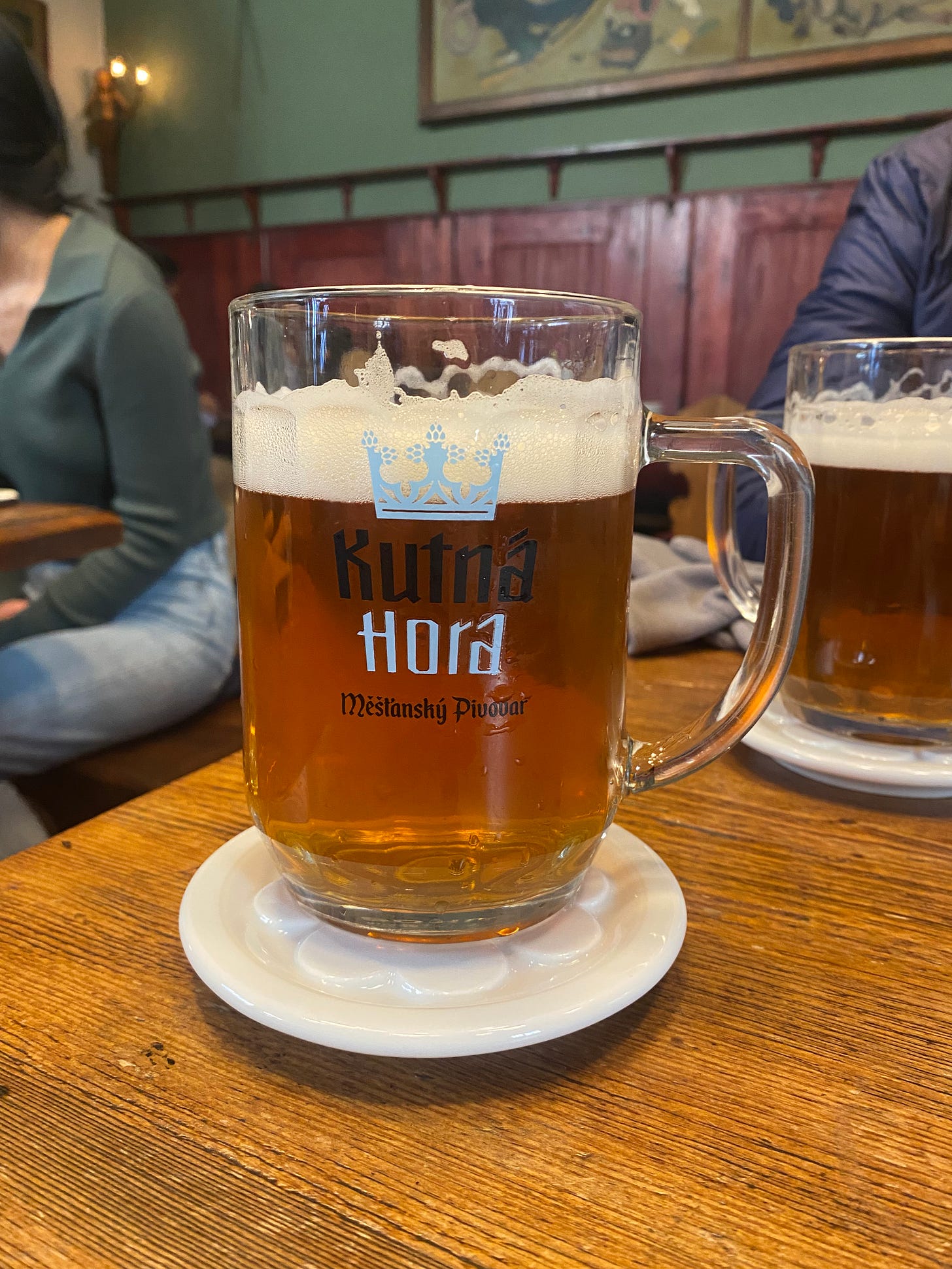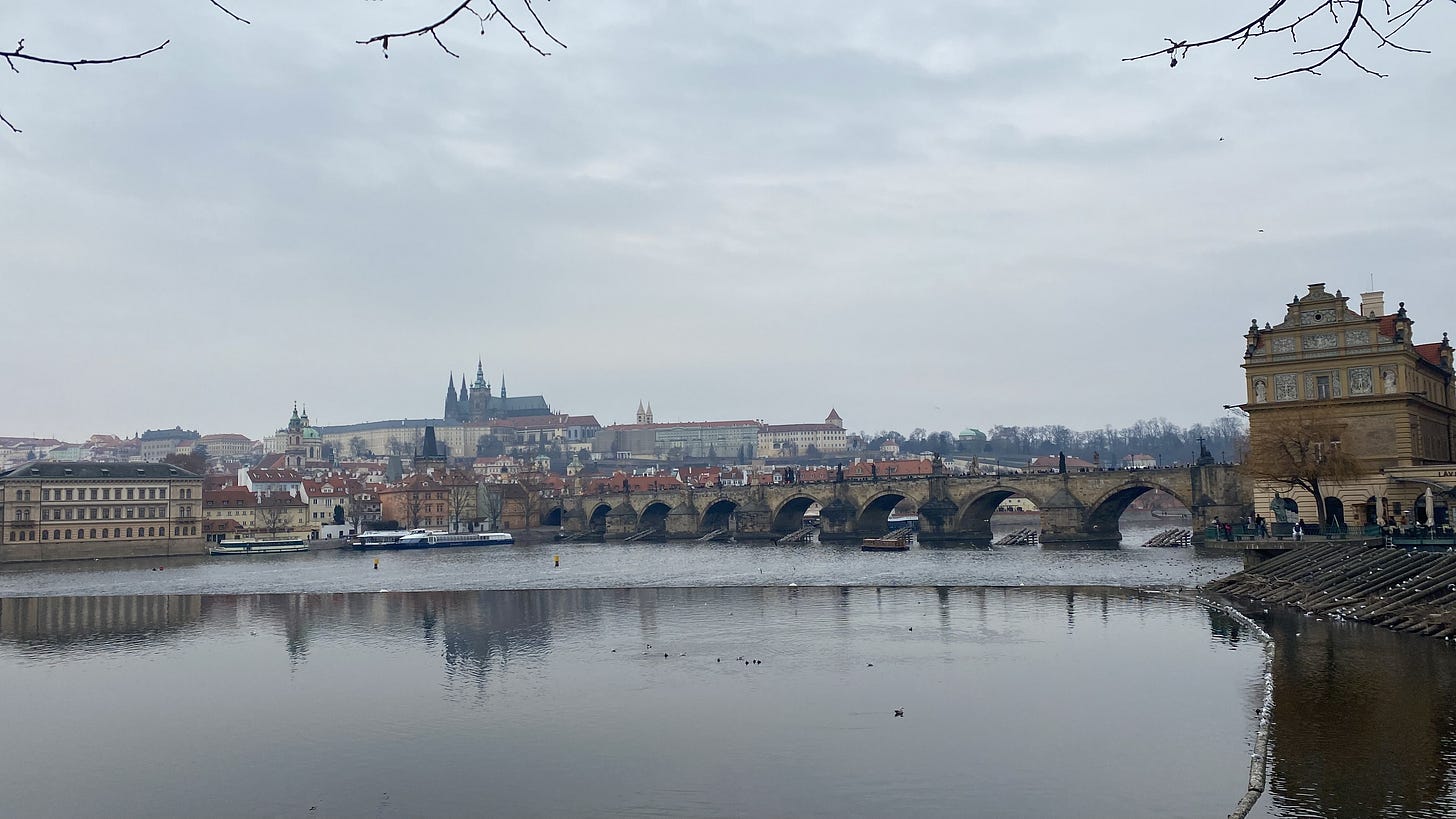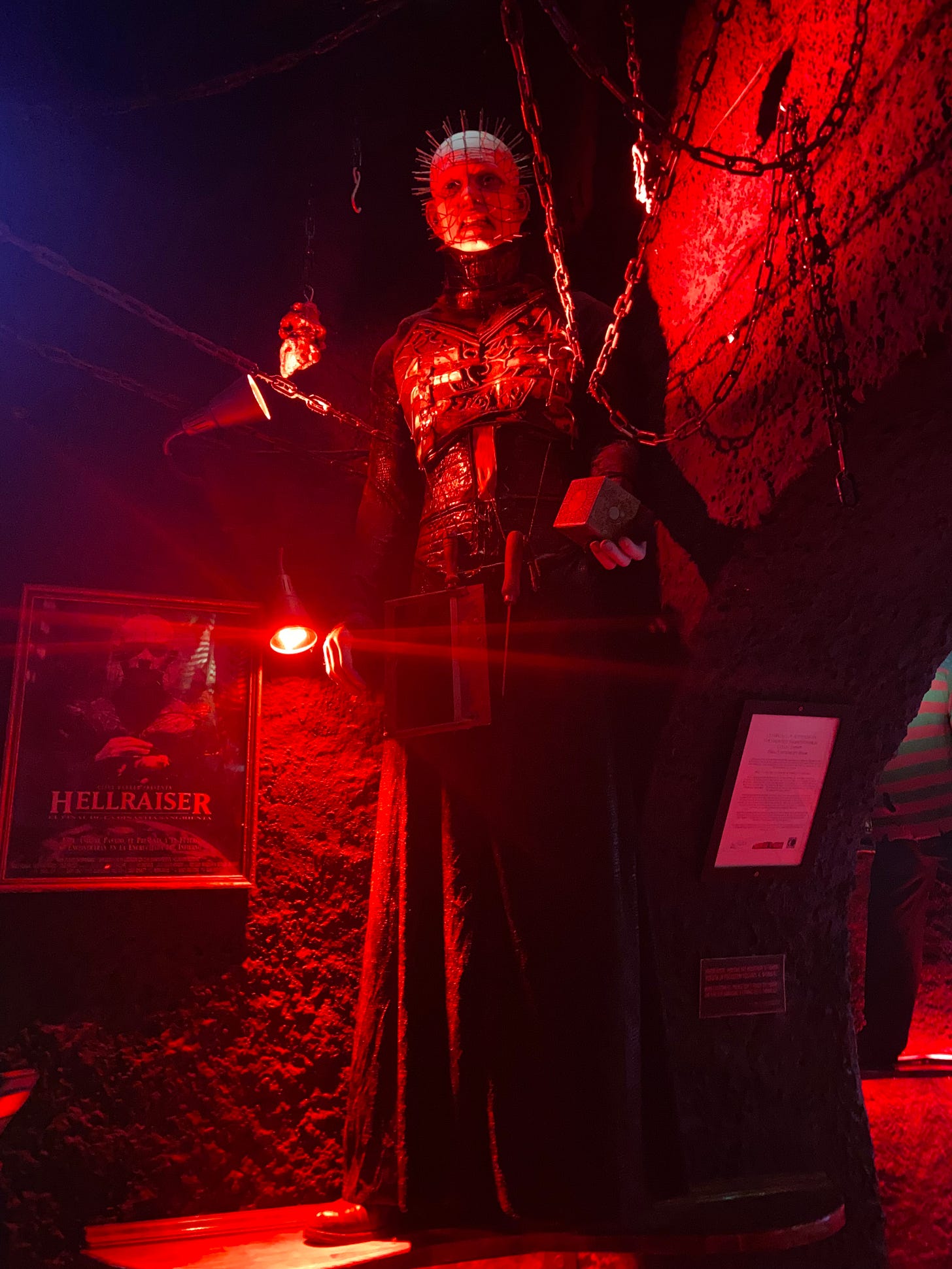Drinking Czech Pilsner at a Lego Museum
Sometimes the setting makes a drink, sometimes you just need to buy something to use the loo.
For a beer lover the Czech Republic is a sort of Malt Disneyland, where everywhere you look there’s beer, and it’s cheaper than water! Here you can drink incredibly well made beers in settings that are as diverse as genuine medieval basements, bohemian cafes, and soulless beerhalls, accompanied by pickled cheese and intimidatingly large joints of meat.
I didn’t go to Czechia to drink beer, but it’s such a pervasive part of everyday life there it is hard to escape. On a morning walk we saw people already drinking beer at pavement cafes, and whilst waiting for a train at a station watering hole most were happily sinking pints before 11am. I am not wholly convinced that people there see beer as an alcoholic drink, and even if I don’t join them for a morning constitutional, if beer is as good and cheap as it is in Prague, I can see the temptation.
The Czech’s really love beer! Image copyright Pintsandpanels
Czech beer is so good, in part, because of the water. The soft water there dries your skin out, but makes your hair feel amazing, it also has a low ion content which allows the delicate hop character of Czech beers to really shine. Czech water typically has low levels of calcium, and calcium is an important co-factor in many enzymatically driven reactions in the brewing and fermentation process, leading to some unique characteristics only found in Czech beers. Calcium is also important for clarifying beer, if your beer is deficient in calcium the natural sedimentation of haze takes an awful lot longer. This is why Czech pilsners are allowed to mature in large horizontal tanks for up to 90 days, for contrast a lager brewed in a UK craft brewery might be out the door in under 4 weeks. During this time the yeast cells die and burst open, spilling out enzymes that continue to interact with the residual sugars in the beer leading to the formation of a small amount of diacetyl, a compound with a distinct butterscotch aroma that is usually considered to be a fault in most other beer styles. The dying cells also release glycerin into the beer, giving it body and a greater drinkability. In Czech beers the mass grave of dead cells at the bottom of a fermentation vessel actually does a lot for the taste of the beer.
Czech breweries also use a long and slow fermentation. Most ales are fermented relatively warm, but lagers use a different yeast and work better at lower temperatures. Lager yeast, or saccharomyces Pastorianus as it’s known to brewers has been long thought to be the result of a natural hybridisation between an ale yeast and a wild yeast on the plains of Patagonia! Yeah, your Czech pilsner started off life in the remarkable fungal biodiversity of southern Argentina, obviously. There are competing theories, but I like the idea of something managing to make its way from Argentina to Central Europe, and some long-dead brewer deciding that the beer from his particular cave was the best, and now we all have to drink Carlsberg.
This long and slow fermentation gives a cleanness to beer, a distinct crispness, a little of the butterscotch diacetyl and a touch of natural carbonation. Czech hops are also delicate, floral and used to good effect by frugal brewers.
As I said, I didn't travel to The Czech Republic to drink beer. I was really quite unwell when I was there, and with hindsight should probably have just stayed at home. I’d spent most of the morning before I left in A&E, coughing up blood, with doctors trying to work out if I was experiencing a pulmonary embolism. I wasn’t. I’d just coughed so much I tore a blood vessel somewhere in my respiratory system, no real damage done. So armed with a large amount of codeine and a burning desire to just go to bed with Radio 4 and some tea I instead got on a Wizz Air flight to Prague.
It’s only a short hop to Prague, and the airport is easily connected by taxi or public transport to the centre. Seeing the beautiful skyline of the city emerge from across the river as you cross at night is spectacular. Prague is an incredibly beautiful city, and I think if I hadn't have felt quite so rubbish the whole time I think I’d be planning another trip back.
I travelled with my boyfriend Jowan and my friend Maria, an Estonian of Russian decent who has been my translator in many situations where my Russian is far too rudimentary to manage. She’s a bit of a horror fan, and her one request was to visit Seldec Ossuary in Kutna Hora, about an hour on the train from Prague. The basement of this graveyard church is known around the world for the somewhat quirky way that the Victorian townsfolk decided to deal with a large buildup of bones, some dating back to the Black Death and Crusades. Instead of piling them up in forgotten tunnels or large pits, the bones were instead lovingly cleaned and artfully arranged into chandeliers, candle holders, pyramids, and even the crest of a local noble family, using every bone from the human body. It costs £15 to get in, and you cannot take photos, but I found it quite a peaceful place. It might seem disrespectful and obscene, but these people chose to be laid to rest here, in a church where soil from the Golgotha was sprinkled, making it a very holy site to those who believe.

In part it might be coming from a medical family where death was discussed in a very matter of fact way, and with parents who dealt with death daily, but I didn’t find it unsettling, unlike Maria who decided not to spend long in there. Your ticket also gets you entry to two churches, the most spectacular of which is the Cathedral of St. Barbara, with medieval frescoes depicting life in the town 600 years ago. You can still see the well preserved images of minters, miners and musicians and some spectacular altars. All in all these activities will take up an hour, and Kutna Hora in February is not exactly the most happening of places, so my advice, as always, would be to find a beer.
After visiting the ossuary, if you’re anything like me and decided that a big bottle of Diet Coke on the train wouldn't present problems, you’ll need the loo. There’s a public toilet near where you buy your entry ticket, but you need cash for it, and so in this land where beer is cheaper than water I’d recommend popping into the Museum of Bricks for a quick drink, and using the loo in there.
Lego, obviously, isn’t Czech. It’s the pride of Denmark, but an eccentric Czech man has amassed the largest Lego collection in the world and has opened a number of museums to showcase his pride and joy. I absolutely love when people adore something so much they want to share it with the world, no matter how incongruous or strange. In Kutna Hora two bastions of unusual architecture sit side by side, and you should absolutely visit them both.
The rest of Kutna Hora is probably best seen in summer. It was a sunny day, but most things were closed apart from a museum of film props and a medieval themed restaurant. We all know that these establishments are tourist traps, but being hungry, tired, somewhat unwell and now in need of a follow up wee, it seemed like the best option. We tried the local Kutna Hora beer, which was well made and well priced, coming in at about £3 per pint. Like most Czech breweries they offer a light beer and a dark beer. The dark beers are usually delicious too, with a distinct malty character and notes of molasses and brown sugar balanced with the delicate noble hops. The food was the classic Czech tourist option, fried cheese and pork ribs with a fairly anomalous BBQ sauce betraying the fact that you are not, in fact, in the year 1327.
This kitschiness extends to a number of establishments in Kutna Hora, and I always associate kitsch with The Czech Republic, somewhat as a vestigial impact from reading The Unbearable Lightness of Being by Milan Kundera when I was 13 or so. In it the distain of kitsch is a recurring theme amongst the somewhat unlikeable main characters. I do find that unlike in the UK and the USA these establishments in central and eastern Europe do at least attempt to make an effort, so although the staff may be dressed as feudally repressed peasants, the food and drink are still better than the UK equivalent, so perhaps some distain can be reserved.
If you’re looking for something a bit lighter then the cash only record shop-cum-cafe, Blues Cafe, is well worth a visit. They carry strange records from Communist days, and sometimes you can pick up some of the faultily reproduced bootleg records that survive from the USSR, when western decadence infiltrated through elicit means. Small bars such as U Kupkru are also open all winter, and you will often have the place to yourself, unlike in the UK the beer will still be well kept and the lines clean, so even in a quiet bar the beer should be good.
When you take the train back to Prague the beer trolley might be hard to find, so stock up on some cans before you leave town. The main station is on the outskirts, a good 50 minute walk from the centre, and taxis can be hard to come by once most of the locals have turned in for the night. In Prague try out Cafe Jericho for a bohemian experience with good value lunch offers, and the Lokal chain for good beer.
Absinthe is associated with Prague, and poor quality spirit in plastic bottles with garish, perhaps even kitsch, labels are available all over the old town. These drinks are squarely targeted at the Stag Do crowds, and although studies have found that there are few psychoactive effects from absinthe other than its scarily high ABV, as an alcohol professional and one who will usually try any moonshine, give these a wide berth. Instead head to Hemingway bar, where you can get an absinthe cocktail or try a properly made serving instead of dodgy hootch with green colouring.
If you do decide to wholly surrender to kitsch, then take the tram over to Prague Horrorbar, where you can sit amongst life sized replicas of character from horror movies and drink disgusting shots with baileys and watermelon liqueur. The menu here is, ostensibly, cocktails- albeit with a reliance on something called “sweet-sour lemonade”. They also do a negroni, if you’re simply above drinking a “Zombie Foetus”.
You will get good beer wherever you go, and there are many bars that have small breweries in them, and you could go for hours stopping off for a half pint at each. I didn’t have a single bad beer in Prague, so whatever your bar preference may be, you’ll never be left wanting for a good beer.









